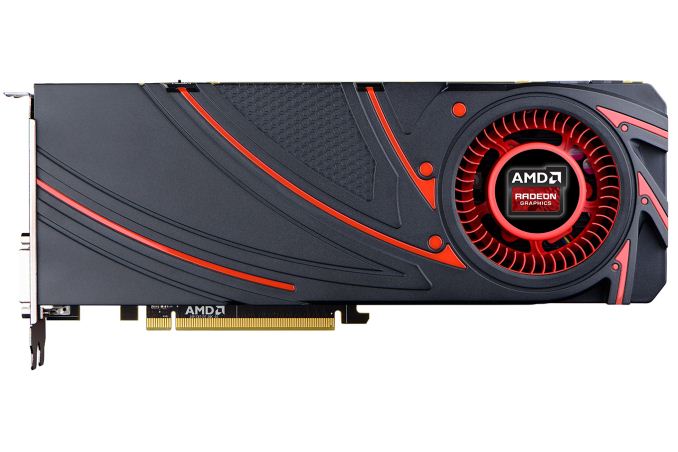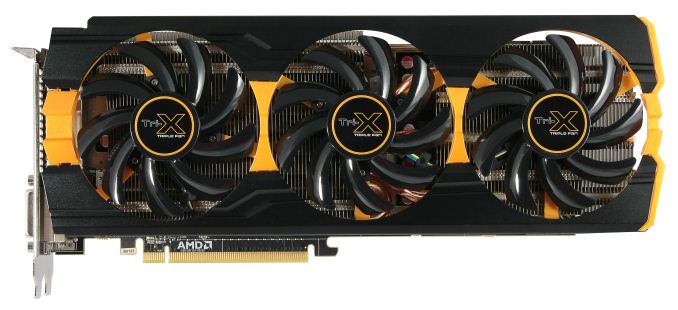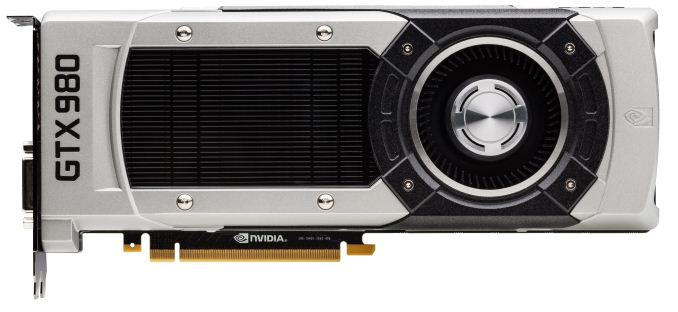AMD Radeon R9 290 Series Prices Finally Begin To Fall
by Ryan Smith on October 7, 2014 12:00 PM EST
With the launch of NVIDIA’s Maxwell-powered GeForce GTX 900 series last month, it was immediately obvious that NVIDIA had been able to deal a swift blow to AMD’s product lineup by surpassing AMD’s performance while significantly undercutting their pricing. At the time we were expecting AMD to quickly respond with the necessary price cuts to keep the R9 290 series competitive with the GTX 900 series, but surprisingly even a week later this had yet to happen.
Now a bit over two and a half weeks after the GTX 900 series launch, we’re finally seeing Radeon R9 290 series pricing fall in response to NVIDIA’s launch. AMD has not announced an official price cut at this time – and admittedly neither AMD nor NVIDIA tend to announce reactive price cuts – so it’s not clear whether this is AMD’s doing, board partner’s, retailers, or most likely all three. But regardless, retail video card prices at Newegg and other etailers have seen some substantial drops that help bring back at least some balance between AMD and NVIDIA’s high end video card lineups.
A number of Radeon R9 290 cards can now be found for around $300 after rebate, with a couple more factory overclocked models at $310. With HIS, Sapphire, PowerColor, Asus, and XFX represented, this is a broad selection of vendors with a bit less than half of Newegg’s stock now at or around $300. Meanwhile R9 290X can be found for $399, again with a wide selection of vendors and roughly half of Newegg’s stock at or near that price. The remainder of Newegg’s stock in turn generally consists of heavily overclocked or otherwise premium cards that carried their own price premium before these latest cuts.
Speaking of AMD card prices, it should also be noted that AMD’s Never Settle Forever bundle is still active even after this round of price cuts. AMD and their partners will be continuing to try to influence the value proposition of their products by including free games.
For AMD these price cuts don’t come a moment too soon, and while they are going to help the competitive landscape I’m not convinced this is the last time we’re going to see AMD cut prices. As we discussed in our review of the GTX 970, comparing stock-to-stock, the $329 GTX 970 is every bit as fast as the now $400 R9 290X. If AMD wants to be price/performance competitive with NVIDIA then there’s still an additional $70 price difference between the two cards, a gap further muddied by AMD’s game bundle and NVIDIA’s superior energy efficiency. Strictly speaking $400 may not be low enough for the R9 290X, but no doubt AMD wants to see what sales are like at $400 before cutting prices on their single-GPU flagship any further.
The R9 290 on the other hand is in an interesting spot. At resolutions below 2160p it trails the GTX 970 by around 10%, but then again at $300 it’s also priced about 10% lower. Since it ships at a lower clockspeed than R9 290X a lot of AMD’s partners also goose the core clock on R9 290, which improves performance a bit but isn’t enough to close that 10% gap. What it does mean however is that at least so long as energy efficiency is not a concern, R9 290 is appropriately priced for its performance. However if energy efficiency is a concern, then AMD doesn’t have any kind of counter to GM204 at this time.
If anything the one wildcard at this point is the availability of the new GeForce cards. Despite stock more-or-less holding up immediately post launch, we’ve seen both the GTX 980 and GTX 970 go out of stock in the last week. As of the time of this writing it looks like Newegg has received their Tuesday shipment, so there is stock available, but it’s a thin selection of just a few different cards (including a model or two at MSRP). For prospective buyers this means either playing inventory games or grabbing the AMD alternative, and for AMD this is all the more reason not to cut prices too drastically while GeForce availability is still limited. As for NVIDIA it’s been a while since we’ve seen them capacity constrained on the high end, so while it’s solid evidence that they’ve done everything right with the GTX 900 series launch, it does mean that they’re also going to be leaving sales on the table until supply and demand level out.
| Fall 2014 GPU Pricing Comparison | |||||
| AMD | Price | NVIDIA | |||
| Radeon R9 295X2 | $1000 | ||||
| $550 | GeForce GTX 980 | ||||
| Radeon R9 290X | $400 | ||||
| $330 | GeForce GTX 970 | ||||
| Radeon R9 290 | $300 | ||||
| Radeon R9 280X Radeon R9 285 |
$250 | ||||
| Radeon R9 280 | $200 | GeForce GTX 760 | |||
Source: The Tech Report












69 Comments
View All Comments
garadante - Tuesday, October 7, 2014 - link
So much this. And I remember seeing that the 290X power draw decreased when it wasn't running at a blistering 95 C. And anandtch could easily compare efficiencies by putting a lowish frame rate cap on cards so the CPU is working the same. Compare average gpu utilization for frame rate with power draw. Also people need to remember AMD's flagships are competent with compute which wastes die area and power from a gaming standpoint. Gm204 is a lean mean gaming machine but not so for compute but it gives it the die area and power advantage. Sorry for any typos, typing this from a phone.MrSpadge - Wednesday, October 8, 2014 - link
Using a frame rate cap to compare efficiency would be great for mobile gaming, as it represents a realistic and clever operating mode which could really be used over there. But for desktop systems this would not be representative of what people actually use.And regarding AMDs good compute capabilities: while I envy them I'm using nVidia for my compute tasks, simply because they need CUDA. And the only compute benchmarks being compared are using OpenCL, where nVidia limits their performance on purpose by not providing their best compiler. This is their real world OpenCL performance - but it's not representing what the cards are capable of using optimized software.. which is readily available with CUDA. In summary: I'm not convinced the compute difference is as large as the OpenCL benchmarks show, if using CUDA is an option.
Flunk - Tuesday, October 7, 2014 - link
Multi-GPU setups tend to start dropping off in gains after 2 cards. A lot of games aren't really set up for 3 or 4 GPUs and sometimes the performance is actually worse. Even 2 cards can be annoying if you're playing new games that don't have profiles yet or old games that aren't supported.The Von Matrices - Tuesday, October 7, 2014 - link
You can't use any *70 card in 4-way SLI. Only the *80 cards and Titans support 4-way SLI.piroroadkill - Wednesday, October 8, 2014 - link
I agree, basically. It's the lower power that does it. Newer and shinier I don't care about, but given two cards with similar performance at the same price, NVIDIA is offering a cooler running card. They're still winning.TiGr1982 - Tuesday, October 7, 2014 - link
GPU price wars are definitely a good thing for consumers. Not so for AMD this time, though.IMHO, the main issue for AMD here is that the power efficiency of their 28 nm GCN GPUs hasn't really improved at all since the launch of the very first GCN GPU, Tahiti, around 3 years ago - back in December 2011.
Simple example: R9 290X is around 60% faster than my HD 7950 Boost at around the same frequency (that's just, roughly speaking, 44 GCN compute units in R9 290X vs 28 compute units in HD 7950 Boost), but R9 290X is at the same time 50-60% (~100 W) more power hungry. So essentially there seems to be no power efficiency progress with their top GCN GPUs so far (from Tahiti to Hawaii).
So, AMD should clearly do something about this in their future products.
Mondozai - Tuesday, October 7, 2014 - link
Tonga is going to be a lot better than Hawaii was. Although, my 290 Tri-X works very well with the vast majority of games. It's super-quiet and has very low temperatures and I have only 2 fans in my case, as I give a premium to a smoothly sounding PC.If 290 gets to about 270 dollars or so, the value proposition becomes that much more compelling. Nvidia is not going to have HBM next year, which AMD will have. Until then, AMD could/should build goodwill by going further on the price war. The driver's are pretty damn good right now, certainly better than their reputation.
TiGr1982 - Tuesday, October 7, 2014 - link
Tonga is somewhat better from the power/performance perspective, but the issue with Tonga is that it's not a top GPU, but just a better Tahiti replacement, and there is still no full Tonga card ("Tonga XT") like R9 285X as of yet. It may be released later, however, who knows.Rumors about HBM for AMD Radeons next year are unconfirmed; hopefully, these can be true next year (it's still too early for this stuff to be really disclosed, I guess).
MrSpadge - Wednesday, October 8, 2014 - link
Tonga is a little more efficient, yes, but it can still not match Kepler. Just compare R9 285 and GTX670: both are cut-down to a comparable degree, consume about the same power, whereas GTX670 is faster and a significantly cheaper chip.HisDivineOrder - Tuesday, October 7, 2014 - link
Things are going to look very grim for AMD once the 960 releases. Given that the 970 is already at the $300-350 range (best case scenario with sales to come once it stops selling out), the 960 is likely to hit a $250-275 range, which is where the currently released R9 285 (AMD's first Tonga part) is.Assuming that the 960 is every bit the hellion that every Maxwell thus far out the gate has been, you have to imagine that at $250-275, it's going to wallop AMD hard in a duel against the lower end Tonga.
Which leaves room for the uncut Tonga... where? 275-295? Yeah right. Price drops should bring the newer Tonga essentially to slot in where they originally positioned the current Tonga, which immediately undercuts its profit margins before it's more than a month out the gate. And that's assuming that even the unreleased Tonga can match the 960 or even come close. It might not. Given the tendency so far, nVidia's got a real winner with Maxwell while Tonga came in at essentially JUST matching the Tahiti parts it's replacing. That won't be enough.
And that's assuming nVidia doesn't pull another 970-like move and really go for the kill with a $200-230 price point on the 960. That'd squeeze AMD's latest GPUs into trying to find a profitable place in the $200 or less markets...
It's hard to believe that these cards could just come out of nowhere and crush AMD's entire product stack so easily, but I guess that's what happens when you sit on essentially the same products you designed over two years ago, rebadging and slowly trickling out the newer designs meant for months over the course of years...